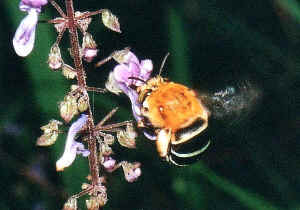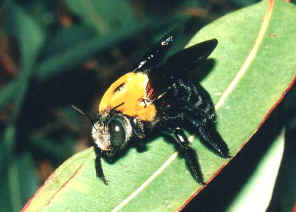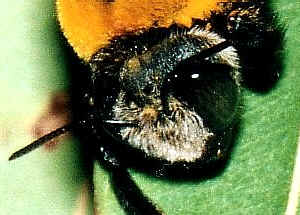|
|
Family ANTHOPHORIDAE- Bees
This family contains some largest bees in Australia. They make nest in dead tree branches or underground. They are solitary bees but some species may nest close together in large numbers. Some species are parasites of other bees' nests. They lay their own eggs in the brood cells of the host bees.

- Blue-banded Bee
Some members in this family, like the Carpenter Bees and the Blue-banded Bees, are known as buzz pollinators. They use special technique to get the pollen from flowers known as buzz pollination. They hold the flowers and vibrate with loud buzz sound. The vibration excited the flower which drop the pollen onto the bees body. The other insects do not know this technique cannot get the pollen.
They have long tongues which allow them to reach the nectar in tubular flowers. Of course they feed on shallow flowers as well.
None of these bees pose a serious threat to us, although the females do possess stings.
- Blue-banded Bees


- Amegilla sp., body length 15mm
- The thorax and head of Blue-banded Bees are covered with golden hairs and abdomen is banded with pale blue bands on black. This is a solitary bee but females may build nest together in same location with other Blue-banded Bees. Their nests built underground. Male do not build nest. They will cluster for the night hanging from stems or leaves by their jaws. More information and pictures please click here.
- Carpenter Bees


- Xylocopa aruana Body length 25mm
- They are very large and hairy bees, with black abdomen and yellow thorax. Theirs wings are dark brown in colour. They are solitary, i.e., living on its own, not like the Honey Bees that living in group. In late spring, we found it resting on a footpath, could not fly nor walk, seemed having some problems. We took it home, for the next day it seemed become normal. We let it go. It flied away and disappeared within seconds. They feed on pollen. Females make tunnel and lay eggs in decaying wood, including dry flower sticks of grass-trees Xanthorrhoea.
